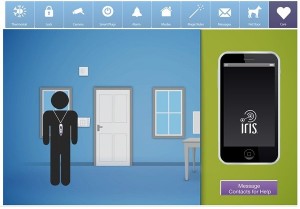Cool Trends and Stuff at CES 2013
, Posted in: Inspiration, Author: nleavitt (January 27, 2013)
 According to the Consumer Electronics Association (CEA), the Arlington, VA-based trade association that owns and produces International CES, there were more than 156,000 attendees and 3,100 vendors at this year’s show. Depending on the time of day, most of them seemed to be waiting in line for a taxi or monorail. Or ordering a chai latte at Starbucks.
According to the Consumer Electronics Association (CEA), the Arlington, VA-based trade association that owns and produces International CES, there were more than 156,000 attendees and 3,100 vendors at this year’s show. Depending on the time of day, most of them seemed to be waiting in line for a taxi or monorail. Or ordering a chai latte at Starbucks.
Despite the usual congestion and often daunting logistical challenges of getting from Point A to B at the Las Vegas Convention Center (LVCC) or nearby hotels where many companies had suites, there were quite a few interesting trends, along with a gazillion gadgets, gizmos and gewgaws. And in certain areas of the LVCC it seemed like every other booth, suite or kiosk was rolling out yet another line of iPhone/iPad covers and assorted accessories.
A number of companies that debuted on sites like Indiegogo or Kickstarter were showing their wares at CES. CNN reported that one of these interesting prototypes was the HAPIfork, produced by Hong Kong-based HAPILABS. The fork keeps track of how many bites of food you ingest – if you eat too fast, you’ll see indicator lights come on that remind you to stop emulating your dog. Eating information is also uploaded via USB to an online dashboard to track your progress.
According to HAPILABS, the fork also measures how long it took to eat your meal, amount of ‘fork servings’ per minute, and intervals between these servings. For those speed eaters, perhaps Version 2.0 might also feature a small electric shock to really get you to stop inhaling your food like a vacuum cleaner.
There were a lot of interesting apps and products aimed at senior citizens. Again, CNN reported that “new sensors can text family members or a doctor if something is amiss in the senior’s daily routine, such as not getting out of bed or skipping medication. If you’re concerned about an elderly relative’s safety, you can use smartphone apps to remotely control security systems, thermostats, and even kitchen electronics.”
In fact, one of these products, called Iris Care, was demonstrated by Lowe’s. Iris Care is a cloud-based home monitoring system; seniors can also carry a $30 pendant which can be used to reach emergency contacts. The system can even send an email to family members if an older relative doesn’t get out of bed at a normal time.
Next gen TV was also hot. LG showed off its CINEMA 3D Smart TV products that included PowerVR Series6 graphics from UK-based Imagination Technologies. Imagination’s VP-Marketing, Tony King-Smith, said that “the next step in TV smartness is to add features inspired by hand-held markets for engaging user interfaces, graphics-rich apps, Internet/cloud connectivity and more. TV is the largest physical display and the one that users spend the most time with. If the look, speed and responsiveness of the TV are not perfect, users will choose other products that do the job better.”
Another UK-based company, Civolution, showed off some innovative content recognition technology. As reported in the Guardian, the technology “can sync second screen experiences in both programs and ads. The company continually monitors around 2,000 TV channels, selling this real-time channel content data on to second screen companies, who can then launch apps fully synchronized with the TV.”
And market research firm CCS Insight said CES 2013 marked the coming of age of the Android platform. Android, noted the company, appeared at the show in cameras, media streamers, video monitors, and even an oven.
CCS Insight added that the smartphone is now a key ingredient in the multi-screen mix. The company estimates there were 1.25 billion smartphones in use last year; rising to 1.84 billion by the end of 2013:
“The smartphone is now assumed as one part of the larger story of the connected home, and just one screen among many, including smart TV’s and tablets…this theme raises big questions for phone manufacturers without a broader portfolio of consumer electronics products, such as HTC, Nokia and RIM.”
CCS Insight indicated that companies like these will need to present a clear message about the value they offer “by focusing on the smartphone as the most used connected device and about how their products are different from the devices offered by the larger consumer electronics providers.”
For the media, CES was the usual three-ring circus. But there were interesting advancements in fields ranging from telecommunications to mobility to healthcare.
Head-spinning, frenetic, noisy, long days/nights, but as always, never boring. Look forward to seeing what International CES 2014 will bring.
Comments